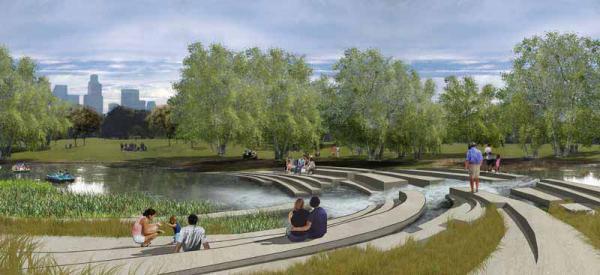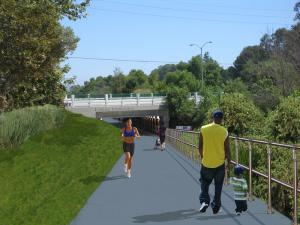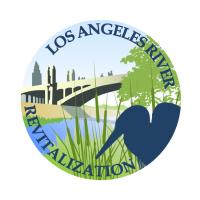Los Angeles River Revitalization Masterplan
From October 2005 until its adoption by the LA City Council in May of 2007, a large team of "riverly" planners, architects, engineers, governmental agencies and residents, led by Pasadena-based Tetra Tech, worked to create a 20-year blueprint for development and management of the Los Angeles River. Their creation, the Los Angeles River Revitalization Master Plan, is an important and visionary document that is being implemented daily.
The full Master Plan document can be downloaded here. The City's river revitalization website can be found at www.lariver.org.
The plan recommends more than 240 projects and a three-tiered governance structure. Our group, the River Revitalization Corporation, was founded in 2009 and serves as the “entrepreneurial” tier. The River Cooperation Committee, founded in 2010, is the “governmental” tier; and the River Foundation, the “philanthropic” tier, is anticipated expected to be created in 2011.

Here are some highlights from the Los Angeles RIver Revitalization Master Plan’s Executive Summary:
Revitalization Master Plan Goals:
REVITALIZE THE RIVER
- Enhance Flood Storage
- Enhance Water Quality
- Enable Safe Public Access
- Restore a Functional Ecosystem
GREEN THE NEIGHBORHOODS
- Create a Continuous River Greenway
- Connect Neighborhoods to the River
- Extend Open Space, Recreation, and Water Quality Features into Neighborhoods
- Enhance River Identity
- Incorporate Public Art Along the River
CAPTURE COMMUNITY OPPORTUNITIES
- Make the River the Focus of Activity
- Foster Civic Pride
- Engage Residents in the Community Planning Process and Consensus Building
- Provide Opportunities for Educational and Public Facilities
- Celebrate the Cultural Heritage of the River
CREATE VALUE
- Improve the Quality of Life
- Increase Employment, Housing, and Retail Space Opportunities
- Create Environmentally-Sensitive Urban Design and Land Use Opportunities and Guidelines
- Focus Attention on Underused Areas and Disadvantaged Communities

SPECIFIC RECOMMENDATIONS FOR REVITALIZING THE LOS ANGELES RIVER
The long-term vision for the River involves restoring a continuous, functioning riparian ecosystem along the River Corridor. This would involve restoring riparian vegetation to support birds and mammals, and ideally, developing fish passages, fish ladders, and riffle pools to allow for restoration of steelhead trout habitat.
In the short-term, channel walls can be modified to provide green landscaped terraces for wildlife habitat, water quality treatment, and increased public enjoyment. A system of pathways and overlooks can provide safe public access. Accomplishing long-term improvements would involve expansion of channel capacity and reduction in flow velocity. These can be achieved through a combination of flood storage outside the channel, underground flow diversions, and, over the long-term, land acquisition, including purchase of private property to allow for channel widening.
SPECIFIC RECOMMENDATIONS FOR GREENING THE NEIGHBORHOODS
A major element of reconnecting neighborhoods to the Los Angeles River is the transformation of the River Corridor into a continuous River Greenway that functions as the “green spine” of the City. Safe, pedestrian-friendly connections to the Greenway can be provided via a system of arterial and local “green streets” that are bicycle- and pedestrian-friendly, and paseos with wide sidewalks and shady tree canopies. To improve habitat connectivity, specific recommendations are presented to aid in the restoration and creation of habitat linkages throughout the River Corridor.
As this system develops, signature elements—gateways, bridges, paseos, plazas, and other landmarks—can be added to reinforce the River’s identity. Building on past efforts, public art can be a major component of this system. Within neighborhoods, underused or vacant space, as well as existing public spaces such as schoolyards, can be refurbished and made a part of the emerging green network and enhanced cultural landscape.
CREATING VALUE: THE BENEFITS OF REVITALIZATION
Making the River green and accessible is expected to transform an undervalued asset into a valued amenity. Revitalization offers the opportunity for communities to engage in development that leads to an improved natural environment, while also attracting investment that leads to new jobs, increased property values, more livable streets, and sustainable growth. To assess the potential benefits of revitalization and to illustrate possible design ideas, different land use possibilities were explored for some of the Opportunity Areas and developed into hypothetical designs and three-dimensional models. Each of these models retains existing significant buildings, and proposes building typologies and massing that are realistic in the prevailing market. The Taylor Yard Opportunity Area’s analysis was devoted primarily to natural and open space considerations. This Area presents great promise as an early example of concrete removal that can result in significant water quality, habitat and recreation benefits. Additionally, the Area’s close proximity to a planned high school makes it an ideal location to create outdoor classrooms and other environmental education features.
To assess the potential benefits of revitalization and to illustrate possible design ideas, different land use possibilities were explored for some of the Opportunity Areas and developed into hypothetical designs and three-dimensional models. Each of these models retains existing significant buildings, and proposes building typologies and massing that are realistic in the prevailing market. The Taylor Yard Opportunity Area’s analysis was devoted primarily to natural and open space considerations. This Area presents great promise as an early example of concrete removal that can result in significant water quality, habitat and recreation benefits. Additionally, the Area’s close proximity to a planned high school makes it an ideal location to create outdoor classrooms and other environmental education features.
Estimates of economic benefits accruing to the proposed revitalization concepts for the selected Opportunity Areas (combined, at full build-out) range from $2.7 to $5.4 billion in new development, 11,000 to 18,000 new jobs, and a long-term tax revenue increase ranging from $47 to $81 million, annually.
A COMMUNITY PLANNING FRAMEWORK FOR REVITALIZATION
Implementation of this Revitalization Master Plan would take place within the existing City planning and zoning context. An important next step, following adoption of this Plan, would be to update existing Community Plans in areas that include the River, through an inclusive community involvement process. The City’s established community planning process is the most appropriate way to formalize revitalization proposals because it gives each unique neighborhood an opportunity to tailor River developments to the sentiments expressed by local stakeholders. Zoning changes may also follow these Plan updates.
To complement the Community Plan process, a River Improvement Overlay (RIO) district would be created, with three important functions:
- Establish a high-quality interface between private property and the River;
- Increase open space and improve environmental quality; and
- Create active pedestrian streets leading to the River.
A MANAGEMENT STRUCTURE FOR A REVITALIZED RIVER
A three-tiered structure is proposed for managing a revitalized Los Angeles River. Because of the multiple public entities with jurisdiction over various aspects of the River, the management structure must be comprehensive, flexible enough to allow these entities to work in collaboration, and comprehensive enough to proceed independently when necessary.
 The Plan’s proposed River management structure includes three elements:
The Plan’s proposed River management structure includes three elements:
- Governmental: The Los Angeles River Authority, a joint powers authority (JPA) that includes the City of Los Angeles, the County of Los Angeles, and through a memorandum of understanding (MOU), the U.S. Army Corps of Engineers. The JPA would serve as the principal entity with authority and responsibility for River reconstruction, right-of-way management and maintenance, assuming responsibilities for public liability, permitting, and land development.
- Entrepreneurial: The Los Angeles River Revitalization Corporation would be a not-for-profit entity charged with directing public and private financing for River-related and neighborhood revitalization projects.
- Philanthropic: The Los Angeles River Foundation would be a not-for-profit body established by private individuals to support the Plan’s revitalization goals.
This new management structure would enable the City and its partners to maintain a long-term focus on River revitalization in order to ensure that the River remains a priority for future generations.
